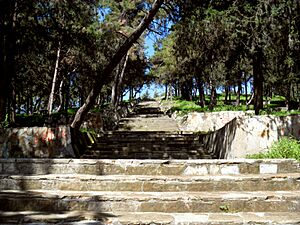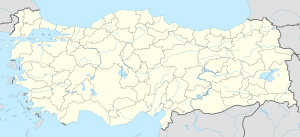Yumuktepe facts for kids
 |
|
| Location | Mersin, Turkey |
|---|---|
| Region | Mediterranean Region |
| Coordinates | 36°48′N 34°36′E / 36.800°N 34.600°E |
| Type | Settlement |
| History | |
| Periods | Neolithic Age to Byzantine Empire |
Yumuktepe is an ancient tell (pronounced "tel"). A tell is a special kind of mound. It forms when people live in the same spot for thousands of years. Each time a building falls down, new people build on top of the old ruins. This creates layers, making the ground higher and higher.
Yumuktepe is located in the city of Mersin, Turkey. Long ago, in 1936, this mound was outside the city. But Mersin grew very fast. Now, the mound is surrounded by city buildings. It is a cool place to learn about how people lived in the past!
Contents
Discovering Yumuktepe
Scientists started digging at Yumuktepe in 1936. A British archaeologist named John Garstang led these first digs. He was a very important person in archaeology. He even started a special research center in Ankara, Turkey.
His team found a very old settlement. People lived here from the Stone Age all the way to the Middle Ages. That's a huge amount of time!
The digging stopped during World War II. Sadly, some important notes about the site were lost. After the war, John Garstang came back. Other archaeologists also joined him. These included Veli Sevin from Istanbul University and Isabella Caneva from Sapienza University of Rome. They helped continue the amazing work.
What We Found at Yumuktepe
Archaeologists have dug down through 23 different layers at Yumuktepe. Each layer shows a different time period. The oldest layers go back to about 6300 BC. That's over 8,000 years ago!
In his book, John Garstang wrote about the tools found here. The very first tools were made from stone or clay. People living here were farmers. They grew crops and also raised animals. They had sheep, cows, goats, and pigs.
Early Fortifications
One of the most exciting finds is from around 4500 BC. In this layer, scientists found parts of a very old wall. This wall was one of the earliest known fortifications (defensive walls) ever built by humans. Imagine building a strong wall to protect your village so long ago!
Ancient Metalworking
During the Copper Age (called the Chalcolithic Age), people at Yumuktepe were very clever. Isabella Caneva found signs of an early copper blast furnace. This was a special oven used to melt metal. This means people here were making things from copper thousands of years ago.
Yumuktepe was probably a settlement right by the sea. But over many years, a nearby river brought a lot of dirt and sand. This dirt slowly filled in the land. Now, the mound is about 2.5 kilometers (1.5 miles) away from the Mediterranean Sea.
Yumuktepe Through History
Yumuktepe was once part of a kingdom called Kizuwatna. This kingdom was connected to the powerful Hittite Empire. In an old document from 1440 BC, a city named Pitura is mentioned. Some people think Pitura might have been the ancient name for Yumuktepe. Other research suggests its name was Elipru.
Around 1300 BC, people called the Sea Peoples attacked many places. They came from Europe and likely attacked Yumuktepe too. Later, the Assyrian Empire also caused trouble for the settlement.
During the time of the Roman Empire, a small city called Zephyrium grew up near Yumuktepe. A Roman Emperor named Hadrian even renamed it Hadrianapolis. But as time went on, another nearby city called Soli became more important. This meant Yumuktepe slowly lost its special status.


